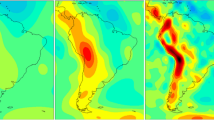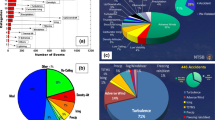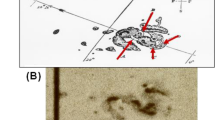Abstract
Currently, the problem of geospace storms and their components, geomagnetic storms, is one of the most important problems in solar-terrestrial physics and space geophysics. The exploration of the geospace and its use for the needs of civilization has led to the fact that our life is increasingly dependent on the manifestations of solar-terrestrial processes, the state of atmospheric-space weather, and ground-to-space systems of various purposes. The more technologically advanced our civilization becomes, the more vulnerable it is to the processes taking place on the Sun, manifestations of solar-terrestrial relationships, and variations in atmospheric-space weather. These circumstances determine the relevance and continuous scientific and practical significance of studies into the manifestations of solar-terrestrial processes and their consequences. Geospace (geomagnetic) storms can be accompanied by a number of effects: variations in the parameters of the atmosphere and geospace; deceleration of spacecraft; impact of increased cosmic radiation on crew and electronic equipment in spacecraft and aircraft; disturbances of conditions of radio wave propagation and channels of radio communication, radio navigation, radio ranging, radio position finding, radio astronomy, and remote sensing; the induction of currents in power transmission lines, cable lines, pipelines, automated railway systems; and the impact on weather- and climate-forming systems. In addition to the physical effects of individual geomagnetic storms, which are described in a large number of scientific papers, a statistical analysis of the parameters of the solar wind, interplanetary magnetic field, and geomagnetic storms over long periods is of interest. The purpose of this study is to statistically analyze the parameters of the solar wind disturbed by solar storms, the interplanetary magnetic field, and the geomagnetic activity indices over the period of solar cycle 24 (2009–2020). The main statistical characteristics of the disturbed solar wind parameters responsible for the geomagnetic storm origins (153 storms in total) over solar cycle 24 have been estimated. The main statistical characteristics of the components of the disturbed interplanetary magnetic field have been estimated, and the main statistical characteristics of the geomagnetic field indices have been obtained. With respect to magnetic activity, solar cycle 24 was quieter than solar cycle 23.









Similar content being viewed by others
REFERENCES
D. V. Blagoveshchenskii, “Effect of geomagnetic storms (substorms) on the ionosphere: 1. A review,” Geomagn. Aeron. (Engl. Transl.) 53, 275–290 (2013).
A. D. Danilov, “F2-region response to geomagnetic disturbances (review),” Geliogeofiz. Issled., No. 5, 1–33 (2013).
A. D. Danilov and L. D. Morozova, “Ionospheric storms in the F2 region. Morphology and physics (review),” Geomagn. Aeron. 25, 705–721 (1985).
L. F. Chernogor and I. F. Domnin, Physics of Geospace Storms (Khark. Nats. Univ. im. V. N. Karazina, Kharkiv, 2014) [in Russian].
L. F. Chernogor, “Physics of geospace storms,” Kosm. Nauka Tekhnol. 27 (1), 3–77 (2021).
E. Appleton and L. Ingram, “Magnetic storms and upper atmospheric ionization,” Nature 136, 548–549 (1935).
E. Blanch, D. Altadill, J. Boška, D. Burešová, and M. Hernández-Pajares, “November 2003 event: Effects on the Earth’s ionosphere observed from ground-based ionosonde and GPS data,” Ann. Geophys. 23, 3027–3034 (2005).
C. Borries, J. Berdermann, N. Jakowski, and V. Wilken, “Ionospheric storms — A challenge for empirical forecast of the total electron content,” J. Geophys. Res.: Space Phys. 120, 3175–3186 (2018). https://agupubs.onlinelibrary.wiley.com/doi/abs/10.1002/2015JA020988.
M. Buonsanto, “Ionospheric storms — A review,” Space Sci. Rev. 88, 563–601 (1999).
A. D. Danilov and J. Lastovička, “Effects of geomagnetic storms on the ionosphere and atmosphere,” Int. J. Geomagn. Aeron. 2, 209–224 (2001).
T. J. Fuller-Rowell, M. V. Codrescu, R. G. Roble, and A. D. Richmond, “How does the thermosphere and ionosphere react to a geomagnetic storm?,” in Magnetic Storms, Ed. by B. T. Tsurutani, W. D. Gonzalez, Y. Kamide, and J. K. Arballo (American Geophysical Union, Washington, DC, 1997), in Ser.: Geophysical Monograph, Vol. 98, pp. 203–226. https://doi.org/10.1029/GM098
J. M. Goodman, Space Weather & Telecommunications (Springer-Verlag, New York, 2005).
J. Liu, W. Wang, A. Burns, X. Yue, S. Zhang, Y. Zhang, and C. Huang, “Profiles of ionospheric storm-enhanced density during the 17 March 2015 great storm,” J. Geophys. Res.: Space Phys. 121, 727–744 (2016). https://doi.org/10.1002/2015JA021832
L. R. Lyons, Y. Nishimura, S.-R. Zhang, A. J. Coster, A. Bhatt, E. Kendall, and Y. Deng, “Identification of auroral zone activity driving large-scale traveling ionospheric disturbances,” J. Geophys. Res.: Space Phys. 124, 700–714 (2019).
S. Matsushita, “A study of the morphology of ionospheric storms,” J. Geophys. Res. 64, 305–321 (1959).
M. Mendillo, “Storms in the ionosphere: Patterns and processes for total electron content,” Rev. Geophys. 44, RG4001 (2006). https://doi.org/10.1029/2005RG000193
Z. Mosna, D. Kouba, P. K. Knizova, D. Buresova, J. Chum, T. Sindelarova, J. Urbar, J. Boska, and D. Saxonbergova–Jankovicova, “Ionospheric storm of September 2017 observed at ionospheric station Pruhonice, the Czech Republic,” Adv. Space Res. 65, 115–128 (2020).
O. M. Pirog, N. M. Polekh, G. A. Zherebtsov, V. F. Smirnov, J. Shi, and X. Wang, “Seasonal variations of the ionospheric effects of geomagnetic storms at different latitudes of East Asia,” Adv. Space Res. 37, 1075–1080 (2006).
N. Polekh, N. Zolotukhina, V. Kurkin, G. Zherebtsov, J. Shi, G. Wang, and Z. Wang, “Dynamics of ionospheric disturbances during the 17–19 March 2015 geomagnetic storm over East Asia,” Adv. Space Res. 60, 2464–2476 (2017).
G. W. Prölss, Ionospheric F-region storms “Ionospheric F-region storms,” in Handbook of Atmospheric Electrodynamics, Ed. by H. Volland (CRC, Boca Raton, Fla., 1995), Vol. 2, pp. 195–248.
B. G. Shpynev, N. A. Zolotukhina, N. M. Polekh, K. G. Ratovsky, M. A. Chernigovskaya, A. Yu. Belinskaya, A. E. Stepanov, V. V. Bychkov, S. A. Grigorieva, V. A. Panchenko, N. A. Korenkova, and J. Mielich, “The ionosphere response to severe geomagnetic storm in March 2015 on the base of the data from Eurasian high-middle latitudes ionosonde chain,” J. Atmos. Sol.-Terr. Phys. 180, 93–105 (2018). https://www.sciencedirect.com/ s-cience/article/abs/pii/S136468261730617X. https://doi.org/10.1016/j.jastp.2017.10.014
Space Weather, Ed. by P. Song, H. Singer, and G. Siscoe (American Geophysical Union, Washington, DC, 2001), in Ser.: Geophysical Monograph, Vol. 125.
D. Vijaya Lekshmi, N. Balan, S. Tulasi Ram, and J. Y. Liu, “Statistics of geomagnetic storms and ionospheric storms at low and mid latitudes in two solar cycles,” J. Geophys. Res.: Space Phys. 116, A11328 (2011). https://doi.org/10.1029/2011JA017042
O. S. Yakovchouk, K. Mursula, L. Holappa, I. S. Veselovsky, and A. Karinen, “Average properties of geomagnetic storms in 1932–2009,” J. Geophys. Res.: Space Phys. 117 (A3) (2012). https://doi.org/10.1029/2011JA017093
M. Yamauchi, T. Sergienko, C.-F. Enell, A. Schillings, R. Slapak, M. G. Johnsen, A. Tjulin, and H. Nilsson, “Ionospheric response observed by EISCAT during the 6–8 September 2017 space weather event: Overview,” Space Weather 16, 1437–1450 (2018). https://agupubs.onlinelibrary.wiley.com/doi/abs/10.1029/2018SW001937.
N. A. Zolotukhina, V. I. Kurkin, and N. M. Polekh, “Ionospheric disturbances over East Asia during intense December magnetic storms of 2006 and 2015: Similarities and differences,” Sol.-Terr. Phys. 4 (3), 28–42 (2018).
Funding
The study was performed with the financial support of the National Research Foundation of Ukraine, project no. 2020.02/0015 “Theoretical and Experimental Studies of Global Disturbances of Natural and Man-made Origin in the Earth–Atmosphere–Ionosphere System.” The study was also funded in part within the state budget research program of the Ministry of Education and Science of Ukraine (registration number 0119U002538, 0121U109881 and 0121U109882).
Author information
Authors and Affiliations
Corresponding author
Additional information
Translated by M. Chubarova
About this article
Cite this article
Chernogor, L. Statistical Characteristics of Geomagnetic Storms in the 24th Cycle of Solar Activity. Kinemat. Phys. Celest. Bodies 37, 193–199 (2021). https://doi.org/10.3103/S0884591321040048
Received:
Revised:
Accepted:
Published:
Issue Date:
DOI: https://doi.org/10.3103/S0884591321040048




